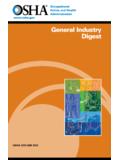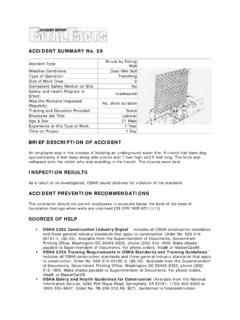Transcription of Construction Industry Digest - Occupational Safety …
1 Construction Industry DigestOSHA 2202-09R 2015 Occupational Safety and Health Act of 1970 To assure safe and healthful working conditions for working men and women; by authorizing enforcement of the standards developed under the Act; by assisting and encouraging the States in their efforts to assure safe and healthful working conditions; by providing for research, information, education, and training in the field of Occupational Safety and This informational booklet is intended to provide an overview of frequently used osha standards in the Construction Industry . This publication does not itself alter or determine compliance responsibilities, which are set forth in osha standards themselves and the Occupational Safety and Health Act.
2 Employers and employees in the 28 states and territories that operate their own osha -approved workplace Safety and health plans should check with their state Safety and health agency. Their state may be enforcing standards and other procedures that, while at least as effective as federal standards, are not always identical to the federal requirements. For more information on states with osha -approved state plans, please visit: Material contained in this publication is in the public domain and may be reproduced, fully or partially, without permission. Source credit is requested but not information will be made available to sensory-impaired individuals upon request. Voice phone: (202) 693-1999; teletypewriter (TTY) number: 1-877-889-5627.
3 Construction Industry Department of LaborOccupational Safety and Health AdministrationOSHA Department of LaborCONSTRUCTION Industry DIGEST3 ContentsForeword 7 general 8 osha Worksite Investigations 8 Frequently Used Standards in Construction 9 Access to Medical and Exposure Records 9 Aerial Lifts 9 Air Tools 10 Asbestos 10 Belt Sanding Machines 12 Chains (See Wire Ropes, Chains, and Ropes) 12 Chemicals (See Gases, Vapors, Fumes, Dusts, and Mists; Asbestos; Lead; Silica; and Hazard Communication) 12 Compressed Air, Use of 12 Compressed Gas Cylinders 12 Concrete and Masonry Construction 13 Confined Spaces 14 Cranes and Derricks 15 Demolition 16 Disposal Chutes 16 Diving 17 Drinking Water 18 Electrical Installations 18 Electrical Work Practices 19 Excavating and Trenching 20 Exits 22 Explosives and Blasting 22 Eye and Face Protection 23 Fall Protection 24 Fall Protection, Falling Objects 26 Fall Protection.
4 Wall Openings 26 Occupational Safety AND HEALTH ADMINISTRATION4 Fire Protection 26 Flaggers 27 Flammable and Combustible Liquids 28 Forklifts (See Powered Industrial Trucks) 29 Gases, Vapors, Fumes, Dusts, and Mists 29 general Duty Clause 30 Grinding 30 Hand Tools 31 Hazard Communication 31 Hazardous Waste Operations 33 Head Protection 33 Hearing Protection 34 Heating Devices, Temporary 35 Highway Work Zones (See Flaggers; Signs, Signals, and Barricades) 35 Hoists, Material and Personnel 35 Hooks (See Wire Ropes, Chains, and Ropes) 36 Housekeeping 36 Illumination 36 Jointers 37 Ladders 38 Lasers 39 Lead 40 Lift Slab 41 Liquefied Petroleum Gas 42 Medical Services and First Aid 42 Motor Vehicles and Mechanized Equipment 43
5 Noise (See Hearing Protection) 43 Personal Protective Equipment 43 Powder-Actuated Tools 44 Power Transmission and Distribution 44 Powered Industrial Trucks (Forklifts) 45 Construction Industry DIGEST5 Power Transmission, Mechanical 45 Process Safety Management of Highly Hazardous Chemicals 46 Radiation, Ionizing 46 Railings 47 Recordkeeping: Recording and Reporting Requirements 47 Reinforced Steel 48 Respiratory Protection 48 Rollover Protective Structures (ROPS) 49 Safety Nets 49 Saws 50 Band 50 Portable Circular 50 Radial 50 Swing or Sliding Cut-Off 51 Table 51 Scaffolds, general Requirements 52 Bricklaying 53 Erectors and Dismantlers 53 Fall Arrest Systems 54 Guardrails 54 Mobile 55 Planking 55 Supported 56 Suspension (Swing) 56 Signs, Signals, and Barricades (See Flaggers)
6 58 Silica 58 Stairs 58 Steel Erection 60 Storage 62 Tire Cages 62 Toeboards 62 Toilets 62 Training and Inspections 63 Occupational Safety AND HEALTH ADMINISTRATION6 Underground Construction 63 Washing Facilities 64 Water, Working Over or Near 64 Welding, Cutting, and Heating 65 Wire Ropes, Chains, and Ropes 66 Woodworking Machinery 67 Workplace Complaints: Workers Rights 67 osha Assistance, Services and Programs 68 NIOSH Health Hazard Evaluation Program 73 How to Contact osha 73 osha Regional Offices 74 osha -Approved State Plans 76 Construction Industry DIGEST7 ForewordThe Construction Industry Digest contains summaries of the most frequently used standards in the Construction Industry .
7 The standards are presented alphabetically followed by the reference to the appropriate regulation. With few exceptions, standards in this Digest are from Title 29 of the Code of Federal Regulations (CFR), Part , this booklet is only a Digest of basic applicable standards and should not be considered as a complete substitute for any provisions of the Occupational Safety and Health Act of 1970 (OSH Act), or for any standards issued under the OSH Act. The requirements discussed in this publication are summarized and abbreviated. The actual source standards are referenced at the end of each topic discussed; consult the CFR for a more complete explanation of the specific standards Safety AND HEALTH ADMINISTRATION8 GeneralEmployers have the responsibility to provide a safe workplace.
8 Employers MUST provide their employees with a workplace that does not have serious hazards and follow all relevant osha Safety and health standards. Employers must comply with specific standards. All employers in the Construction Industry must also have injury and illness prevention programs. Contractors and employers who do Construction work must comply with standards in 29 CFR 1926. Subpart C, general Safety and Health Provisions, as well as other specific sections of these standards, include the responsibilities for each contractor/employer to initiate and maintain injury and illness prevention programs, provide for a competent person to conduct frequent and regular inspections, and instruct each employee to recognize and avoid unsafe conditions and know what regulations are applicable to the work environment.
9 Employees must be provided training in a language and vocabulary they can Worksite InvestigationsOSHA conducts on-site inspections of worksites to enforce the osha law that protects workers and their rights. Inspections are initiated without advance notice, conducted using on-site or telephone and facsimile investigations, and performed by highly trained compliance officers. Worksite inspections are conducted based on the following priorities: Imminent danger; A fatality or hospitalizations; Worker complaints and referrals; Targeted inspections particular hazards, high injury rates; and Follow-up inspections. Construction Industry DIGEST9 Inspections are conducted without employers knowing when or where they will occur.
10 The employer is not informed in advance that there will be an inspection, regardless of whether it is in response to a complaint or is a programmed inspection. Frequently Used Standards in ConstructionAccess to Medical and Exposure RecordsEach employer shall permit employees, their designated representatives, and osha direct access to employer-maintained exposure and medical records. The standard limits access only to those employees who are, have been (including former employees), or will be exposed to toxic substances or harmful physical agents. made applicable to Construction by employer must preserve and maintain accurate medical and exposure records for each employee. Exposure records and data analyses based on them are to be kept for 30 years.











